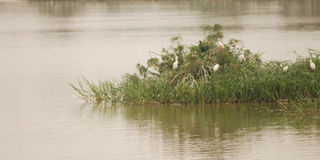Kabaka’s Lake: his highness Mwanga’s positive legacy

Egrets are some of the birds on Kabaka’s Lake. Right, tourists enjoying the lake’s calmness. The lake, where Buganda’s tourism expo water sports events are taking place, was a brain child of Kabaka Mwanga. Photo by Edgar R. Batte
History has demonised Kabaka (king) Danieri Basammula-Ekkere Mwanga II Mukasa as a ruthless leader, mostly for murdering what the world knows as the Uganda Martyrs. Not many have cared to turn the other pages of history to learn about his good deeds.
A few kilometres from the city centre, in Rubaga, at the backdrop of one of Kabaka’s royal palaces, Rubaga Miracle Centre and St Lawrence University lies a peaceful water body, Mwanga’s brain child, the Kabaka’s Lake. It is one of Uganda’s and perhaps Africa’s longest-surviving man-made lakes.
The lake’s beauty is visible, with birds flying from one end to another, before settling on a green patch in its midst. There is also visible human movement as sailors ferry people across.
The Kabaka’s Lake will be hosting one of the major events during the Buganda Tourism Week and His Majesty Kabaka Ronald Edward Frederick Kimera Muwenda Mutebi II, will officiate all the water sports events that will be held there.
Buganda Kingdom’s first deputy prime minister, administration, and minister for Buganda affairs, Hajji Muhamood Ssemambo Ssekimpi explains that water sports events on the lake will take place during the week-long tourism expo, between July 29 and August 4.
“One of the coronation exercises is the Buganda tourism expo, which will be a competition of canoes, boat rowing by children. We have invited Ssabasajja to come and grace the occasion,” the deputy Katikiro adds.
Why Mwanga built the lake
Kabaka’s Lake was one of Mwanga’s achievements. “It was dug in 1886 by Kabaka Mwanga II. His idea was to create a channel which was to take him to his palace here in Lubiri and the other in Munyonyo,” Hajji Ssemambo explains.
Moses Batemyeto, a tourism officer in Buganda Kingdom’s Tourism Ministry elaborates the story of the lake’s history.
“The palace (Twekobe, in Lubiri) has a relationship with the lake (Kabaka’s lake). When Kabaka Mwanga was building his first palace, it unfortunately caught fire and he left. So he went to stay with French missionaries in Nalukolongo. From there, he went to his palace in Munyonyo which had been built by Muteesa,” Batemyeto explains.
The people involved
He adds that he did not like that palace in Munyonyo and when Twekobe was constructed, he returned but would occasionally go to Munyonyo. He thus sought to get quicker means of transport between Lubiri and Munyonyo.
“That is when he called on his subjects to dig this lake since there were good springs in the area. The lake was dug from here in Lubiri to Najjanankumbi, in Luwafu- Makindye.
“The first supervisor of the projects was a one Musoke who was not very hard-working so he appointed Kamya Ndikumulaga who was well-built. He mobilised people to dig the lake to the depth and width,” the tourism officer further narrates, about the history of the man-made lake.
The people who dug were mobilised from the different parishes in Buganda Kingdom. But as Batemyeto adds, the parish chiefs and princesses were not digging so Ndikumulaga reported this to the Kabaka.
“The Kabaka went down and got himself dirty as he dug. The princes and chiefs had no option but to dig along with the Kabaka,” Batemyeto adds.
Ssemambo says that besides creating a water-way, Kabaka Mwanga loved swimming and fishing.
He adds, “At the end of the 11 months of digging, land had been cleared all the way up to Najjanankumbi. If you visited parts of Ndeeba, you would see some heaps of soil, which were just waiting to be hand-lifted out of the way but, a rebellion broke out. That is when the Christians revolted and they started opposing him.”
Ssemambo says: “There are two important things. The lake is not served by any tributary. It is just fed by springs and the water level of this lake has never gone down. In all these years, since 1886 to date, the water level is the same, whether in the dry or wet season.”
Ssemambo says plans are underway to create a buffer zone to cordon off the lake as a measure to minimise silting.




